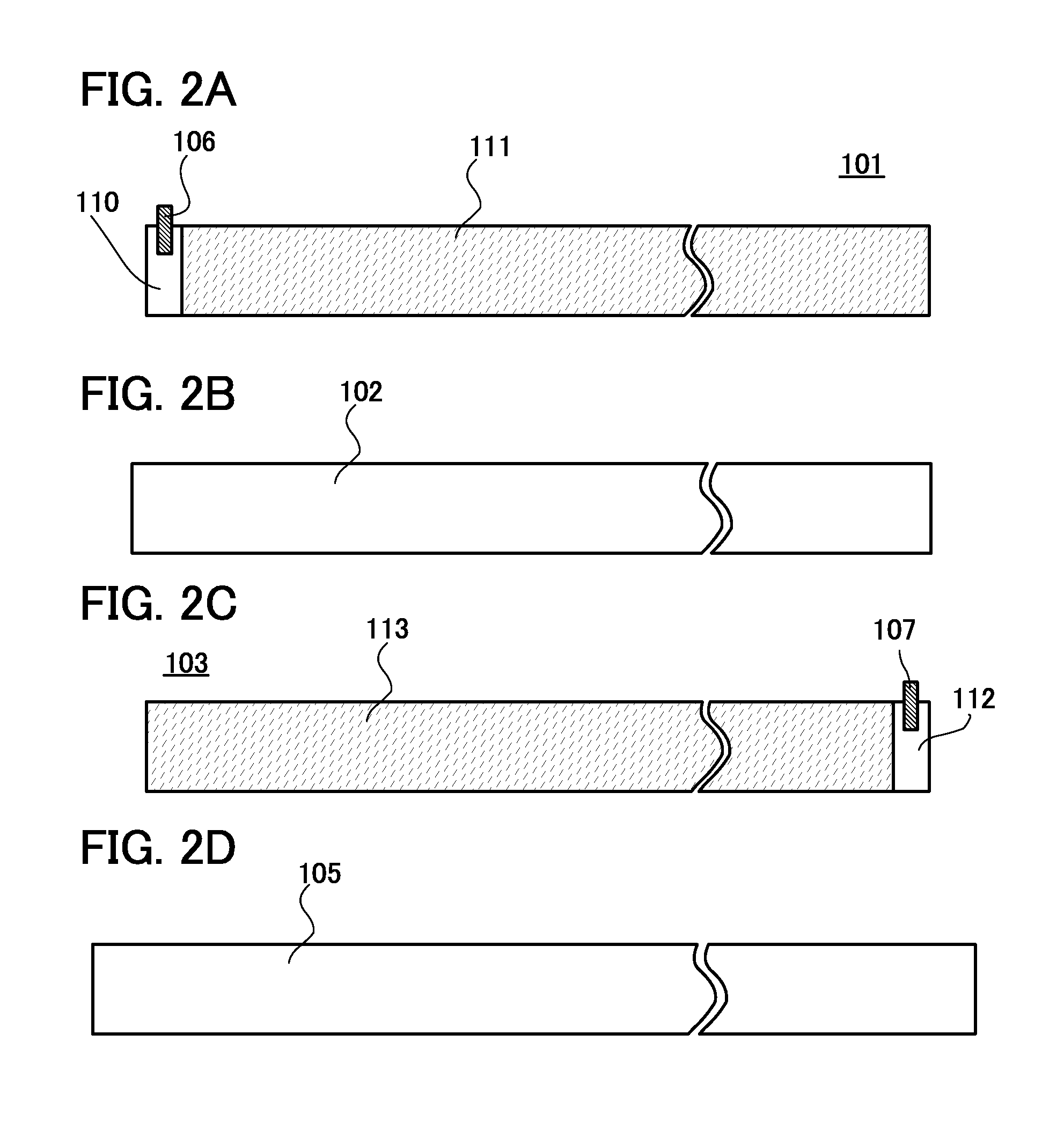Square lithium secondary battery
a lithium secondary battery and lithium-ion battery technology, applied in batteries, wound/folded electrode electrodes, sustainable manufacturing/processing, etc., can solve the problems of reducing discharge capacity, difficult to precisely remove or flake the active material layer in the wound body area, and difficulty in electrode manufacturing technology, etc., to achieve high charge, increase surface area, and increase the density of projections
- Summary
- Abstract
- Description
- Claims
- Application Information
AI Technical Summary
Benefits of technology
Problems solved by technology
Method used
Image
Examples
embodiment 1
[0045]In this embodiment, a structure of an electrode sheet for a square lithium secondary battery will be described with reference to FIGS. 1A to 1B, FIGS. 3A to 3C, and FIGS. 4A and 4B. In the structure, a plurality of openings are formed in a part of an active material mixture layer which corresponds to a bend in a collective sheet in a wound body. The electrode sheet refers to a positive electrode sheet and a negative electrode sheet.
[0046]A lithium secondary battery refers to a secondary battery in which lithium ions are used as carrier ions. As examples of carrier ions which can be used instead of lithium ions, alkali-metal ions such as sodium ions and potassium ions; alkaline-earth metal ions such as calcium ions, strontium ions, and barium ions; beryllium ions; magnesium ions; and the like are given.
[0047]FIG. 1A is a schematic view of a wound body 100 incorporated in a square lithium secondary battery. A positive electrode sheet and the like shown in FIG. 1A are spread for ...
embodiment 2
[0066]In this embodiment, examples of the shape or structure of the electrode sheet, which are different from those shown in Embodiment 1, will be described with reference to FIGS. 7A to 7C.
[0067]FIG. 7A is the same diagram as FIG. 3B, illustrating the shape or structure of the electrode sheet shown in Embodiment 1. In the region 111b with the plurality of openings, the plurality of openings 114 are arranged at regular intervals in the longitudinal direction of the electrode sheet. In FIG. 7B, in the region 111b with the plurality of openings, the plurality of openings 114 are not arranged at regular intervals, but the distance between the openings 114 is gradually decreased closer to the center of the region 111b while being gradually increased closer to the edge. When the openings in the region 111b with the plurality of openings are arranged in such a manner, the margin to compensate for the misalignment in the winding process can be further increased as compared to that in Embod...
embodiment 3
[0070]In this embodiment, examples of the shape or structure of the electrode sheet, which are different from those shown in Embodiment 1 or 2, will be described with reference to FIG. 8.
[0071]FIG. 8 illustrates a cross-sectional structure of the electrode sheet in the longitudinal direction in this embodiment. In the region 111b with the plurality of openings of the electrode sheet, a groove 116 of the current collector, which corresponds to the opening 114, is provided in an exposed area of the positive electrode current collector 110. The groove is not formed in another area of the positive electrode current collector 110 which is in contact with the positive electrode active material mixture layer 111. Accordingly, the surface of the positive electrode current collector 110 in the opening 114 is positioned at an inner side than the surface of the positive electrode current collector 110 in the island pattern 115 made of the positive electrode active material mixture layer 111. W...
PUM
| Property | Measurement | Unit |
|---|---|---|
| particle size | aaaaa | aaaaa |
| thickness | aaaaa | aaaaa |
| radius of curvature | aaaaa | aaaaa |
Abstract
Description
Claims
Application Information
 Login to View More
Login to View More - R&D
- Intellectual Property
- Life Sciences
- Materials
- Tech Scout
- Unparalleled Data Quality
- Higher Quality Content
- 60% Fewer Hallucinations
Browse by: Latest US Patents, China's latest patents, Technical Efficacy Thesaurus, Application Domain, Technology Topic, Popular Technical Reports.
© 2025 PatSnap. All rights reserved.Legal|Privacy policy|Modern Slavery Act Transparency Statement|Sitemap|About US| Contact US: help@patsnap.com



